MELISSA (Micro-Ecological Life Support System Alternative)
Science
MELiSSA (Micro-Ecological Life Support System Alternative) Program — Extra-Terrestrial Ecosystems
Melissa Loop Development Status References
Looking for food that could be harvested by astronauts far from Earth, researchers focused on spirulina, which has been harvested for food in South America and Africa for centuries. ESA (European Space Agency) astronaut Samantha Cristoforetti ate the first food containing spirulina in space and now the knowledge is being applied to a pilot project in Congo as a food supplement. 1)
Preparing for long missions far from Earth, astronauts will need to harvest their own food. ESA’s MELiSSA (Micro-Ecological Life Support System Alternative) team is looking at creating a closed ecosystem that continuously recycles waste into food, oxygen and water.
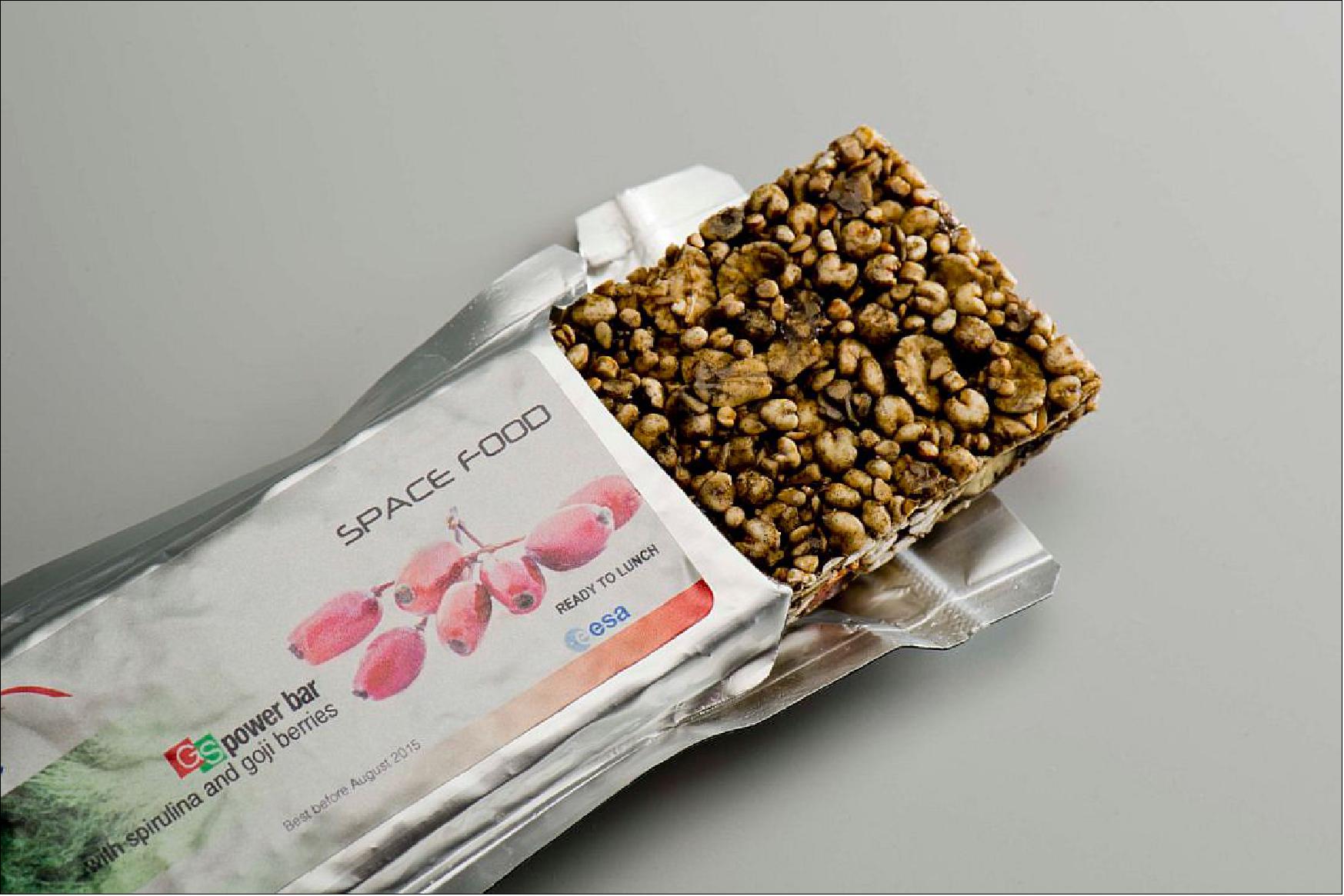
The Arthrospira bacteria – better known as spirulina – have been a staple part of MELiSSA for many years because they are easy to grow and multiply rapidly. The bacteria turn carbon dioxide into oxygen and can be eaten as a delicious protein-rich supplement. They are also highly resistant to radiation found in outer space.
During his stay on the International Space Station, ESA astronaut Andreas Mogensen tested cereal bars containing spirulina collected through MELiSSA’s system to ensure they taste good in space.
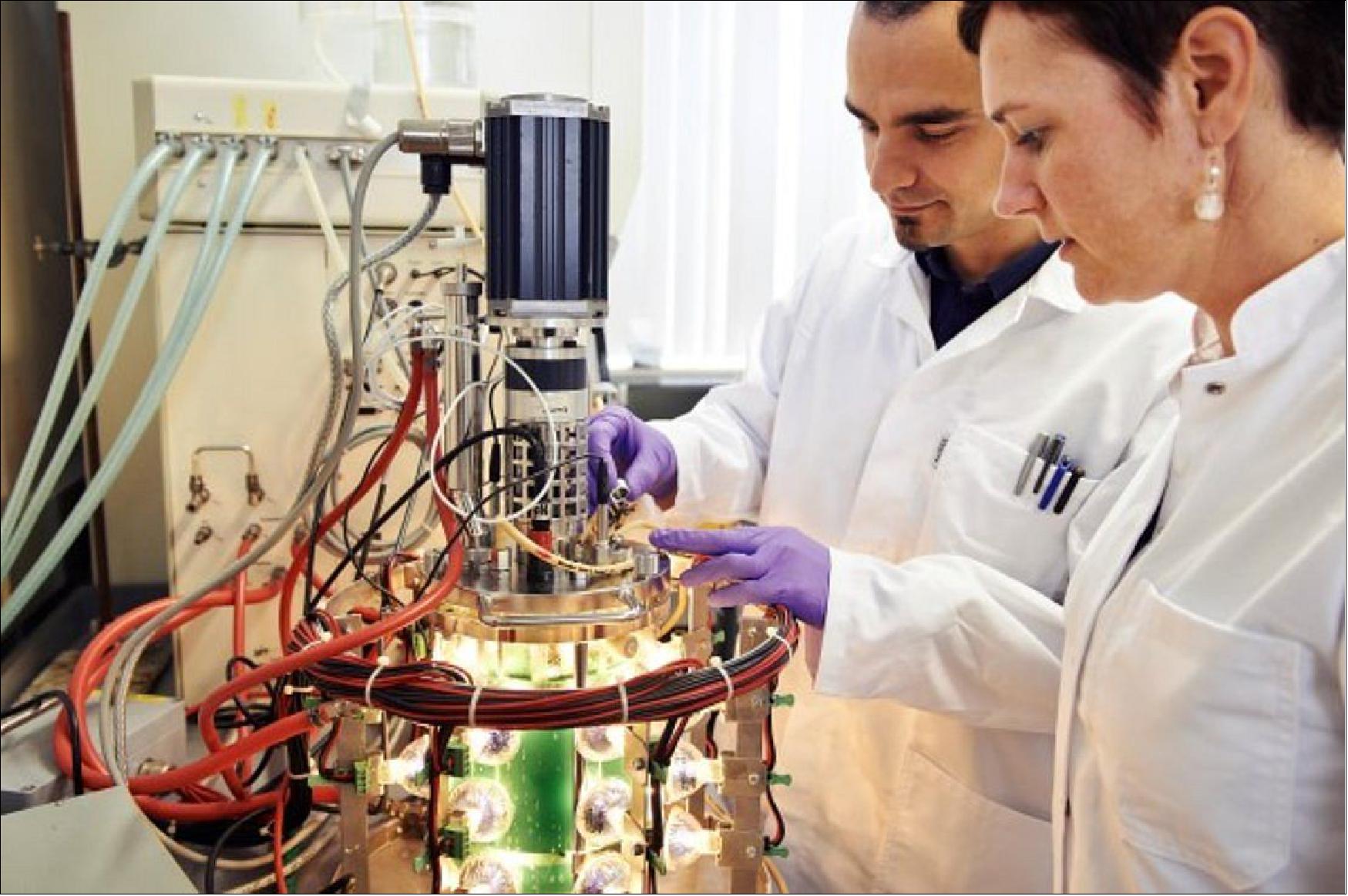
From Space to the Congo
The SCK-CEN (Studiecentrum voor Kernenergie) research center in Mol, Belgium, has been involved since the early days of MELiSSA. Their research into spirulina investigated aspects of the bacteria such as gene expression, enzyme activity, how they absorb light, how they move during growth and how they ingest nutrients. This unparalleled knowledge is now being applied around the Congo town of Bikoro.
The staple diet in this region is cassava, which supplies very little protein, so spirulina could supplement the local diet with much-needed protein as well as vitamin A and iron.
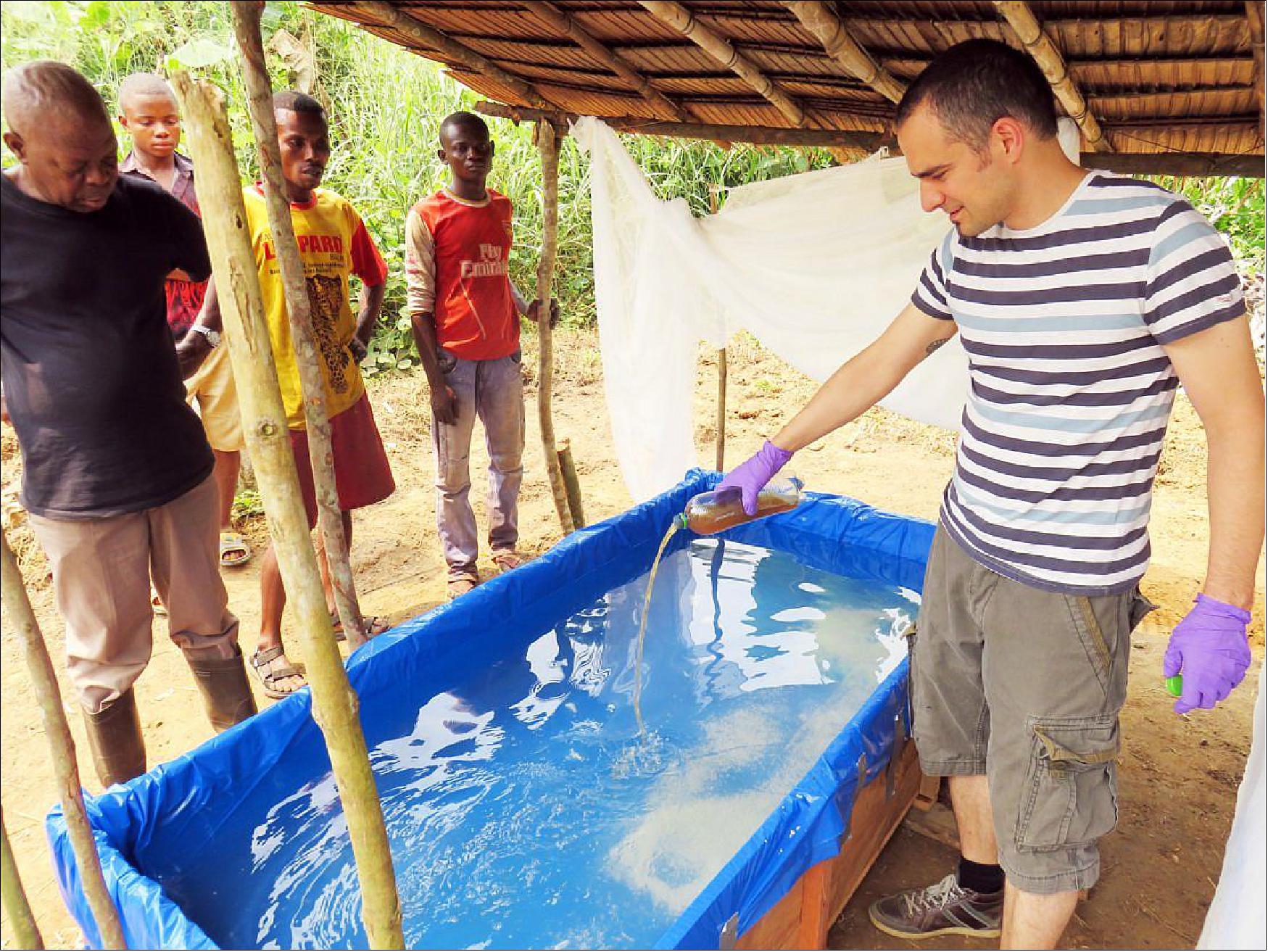
The pilot phase is looking at growing spirulina in tubs of water with potassium bicarbonate and other ingredients that can be found locally. Under sunlight and regular stirring, the tubs are easy for harvesting and provide for a family of six.
The spirulina is dried and powdered, with 10 grams sprinkled on food each day enough to satisfy most dietary requirements – adding a slightly saltier taste to a dish.
Employees from the SCK-CEN research center are working with local entrepreneurs to help make the system a success after beginning in one village.
And Back to Space
Experiments are also planned on the Space Station because nobody knows how some of the organisms in the MELiSSA system will grow in space. A series of experiments will fly the Arthrospira bacteria and cultivate them in the Biolab facility in ESA’s Columbus laboratory to see how they adapt to weightlessness.
“When we started working on MELiSSA over 25 years ago we were inspired by ecosystems such as found around lake Chad 1500 km to the north of Bikoro,” concludes Christophe. “It is fitting that our work creating a circular ecosystem is now helping the local population as well as future astronauts in space.”

Figure 4: Artist's rendition of spirulina (image credit: ESA)
Background on the MELiSSA space research program
MELiSSA is an ESA (European Space Agency) initiative with the aim to develop the technology for a future regenerative life support system for long-term human space missions. Initiated in 1989, the design is inspired by a terrestrial ecosystem. Today MELiSSA is a consortium made up of 30 organizations across Europe.
The MELiSSA (Micro Ecological Life Support System Alternative) program was born with the aim of easing human exploration of the Solar System, while also serving current global challenges such as waste recycling, water provision and food production in harsh environmental circumstances. 2)
During the eighties, a collection of ‘visionaries’ came together to discuss what would actually be needed to recycle waste and carbon dioxide on spacecraft using bacteria, in order to make life in space possible. Indeed, in 1987 it was demonstrated that a super simple closed loop ecosystem of just 2 single algae strains was able to survive a five-day microgravity trip on a Chinese capsule.
Thus, in 1993 Claude Chipaux and Daniel Kaplan of Matra Espace, Professor Max Mergeay of SCK, Professor Willy Verstraete of the University of Ghent and Professors Marcelle Lefor Tran and Guy Dubertret of the French CNRS – came together and signed an agreement with a group of European organizations sharing common interests, in order to pool their efforts in the MELiSSA consortium.
The MELiSSA ‘Closed Loop’ ecosystem project was therefore broken down into 4 Main compartments requiring multiple disciplinary field expertise. This would be to construct a way in which we could essentially ‘terraform’ previously uninhabitable space, and in the words of The Martian, to ‘conquer Mars‘:
- (i) A liquefying compartment which fractions organic waste and provides CO2
- (ii) The photoheterotrophic anoxygenic compartment (where organic carbon should be transformed into inorganic carbon source)
- (iii) A nitrifying compartment for waste detox, and
- (iv) The photoautotrophic compartment, responsible for the removal of CO2 and generation of biomass. Although not finalized, over 32 crops have been considered for the ivB compartment, to generate edible biomass as a food supply.
MELiSSA foundation: The MELiSSA foundation is a non-profit organization created by the MELiSSA consortium for the purpose to manage a fund dedicated to finance a pool of MELiSSA PhD students. The board of the Foundation currently consists of Dr. Max Mergeay (Director) and Rob Suters LLM (Managing Director). The committee in charge of evaluating PhD applications consists of representatives of the MELiSSA community, ESA and independent scientists. The MELiSSA Foundation is a private foundation, PS (Private Stichting), based in Brussels, incorporated under Belgian law. 3)
MELiSSA refers to a space research program aiming to develop an artificial ecosystem for regenerative life support systems for long-term space missions to lunar bases or flights to Mars. The MELiSSA Project is managed by the ESA/ESTEC Thermal and Environmental Control Section (TEC-MCT). The project is based on a collaborative development program between 14 partners and a number of supporting sub-contractors. The partner institutions are:
- ESA (European Space Agency)
- Université Blaise Pascal, Clermont-Ferrand, France
- Ghent University, Ghent, Belgium
- IPStar B.V., Vught, The Netherlands
- SCK-CEN, Belgian Nuclear Research Center
- University of Guelph, Guelph, Ontario, Canada
- Universitat Autònoma de Barcelona, Barcelona, Spain
- Vlaamse Instelling voor Technologisch Onderzoek N.V. (VITO), Mol, Belgium
- Sherpa Engineering S.A., France
- University of Naples Federico II, Naples, Italy
- University of Lausanne, Lausanne, Switzerland
- EnginSoft S.p.A., Mattarello, Italy
- MELiSSA Foundation PS (Private Stichting), Brussels, Belgium
The MELiSSA project has been initiated with the objective develop regenerative life support systems for long term space missions. The main objective of the project is to design and engineer an artificial environment allowing ideally 100% of recycling of waste to produce oxygen, water and food utilizing a combination of waste processing compartments colonized by specific microorganisms or plants. Such an ambitious objective comes with challenges among them the highly multidisciplinary approach and the very long term research. Due to its nature and principal objectives the MELiSSA project requires a strong strategic vision on the interaction between different processes as well as between research institutes.
In order to reinforce this interaction as well as the continuity of the research, national delegations, external audits as well as MELiSSA institutes have recommended to organize a Pool of MELiSSA PhDs, abbreviated: the POMP program. The POMP program is set up to attract students belonging to the faculties of Sciences, Engineering and Agronomy (Bioengineering). The main objective is to organize a European competition for MELiSSA PhD candidates, over six countries: Belgium, Switzerland, Spain, Ireland, Italy and Romania.
MELiSSA Loop
The driving elements for the design of an ideal bioregenerative life support system (BLiSS) are: 4)
1) the production of a highly nutritious biomass and O2
2) with the direct use of light as a source of energy for microbiological biosynthesis
3) with limited O2 consumption
4) in an easy to handle compact reactor setup adapted for space flight
5) allowing an efficient and biosafe re-conversion of waste, CO2, and minerals in simplified recycling steps
6) using known and already studied organisms that (vii) preferably possess a certain degree of ‘space robustness’.
A typical balanced diet contains carbohydrates, fat, and protein as well as a number of vitamins and minerals. Hence, the most important criteria for the nature of the edible biomass are the high production rate and quality of its nutritious compounds. The organisms should equally possess a high rate of O2 evolution and photosynthetic CO2 fixation, combined with a limited volume ratio. Cyanobacteria are the ideal candidate organisms as they generally fulfill the above stated conditions. They are a group of evolutionarily ancient, morphologically diverse and ecologically important bacteria, which are able to carry out oxygenic photosynthesis, while using CO2 as sole source of carbon. They make a significant contribution to the global primary production of the oceans and have become locally dominant primary producers in many extreme environments, like hot and cold deserts, hot springs and hypersaline environments. Among the traditionally consumable cyanobacteria are Arthrospira, the terrestrial cyanobacterium Nostoc commune, and the symbiotic association Anabaena/Azolla. Arthrospira (cf. Spirulina cakes) were grown and eaten in pre-Hispanic Mexico by the Aztecs as “tecuitlatl” and by Kanembu tribeswomen from small soda lakes in the vicinity of Lake Chad as “Dihé” cakes, because of their extraordinary nutritional value.
The main dietary features of spirulines are a very high content of proteins (up to 70% dry weight) with a well balanced aminogram and a high content in vitamins and essential unsaturated fatty acids. In vivo culturing of Arthrospira sp. is easy and very productive. As their growth rate tends to be very high, they are able to produce 20 times more proteins per hectare as compared to soya.
Although trees are the best land plants for absorbing atmospheric carbon dioxide, being able to fix from 1 to 4 tons of carbon per hectare per year, Arthrospira sp. are even more efficient. Research in the California desert with industrially cultivated Arthrospira proved that Arthrospira fixes 6.3 tons of carbon and produces 16.8 tons of oxygen per hectare per year. Furthermore, Arthrospira sp. is very digestive, in contrast to many other microorganisms, notably because of its weak content in nucleic acids and its lack of a rigid cellulose cell wall.
As a consequence, there is no need for cooking or any special treatment before human consumption, allowing for the preservation of the integrity of components like vitamins or polyunsaturated fatty acids. Hence, the easily cultivated food product Arthrospira sp. PCC8005 was selected as the O2 producer and essential food supplement in the conceptual design of the MELiSSA loop (Figure 5). 5)
In order to provide consumers with all the requirements for a complete diet, a plant compartment, achieving the same goals as the Arthrospira sp. compartment, containing lettuce, red beet, and wheat was added to the loop.
With the choice of Arthrospira sp. and a plant compartment as sources of food- and O2-producing compartments, the first two conditions for the design of an ideal BLiSS were met. In additional compartments it was necessary to focus on minimal O2 consumption in simple and compact reactor processing systems enabling efficient and safe waste recycling.
Long-term space missions (e.g., to Mars), including the establishment of a long-term, manned base, implies the development of a reliable life-support system including food supply and waste management. Due to the mission duration, supplying all food, oxygen, and water from Earth will result in a tremendous cost; therefore, the life-support system has to be increasingly regenerative. Presently, on board ISS, technologies are operational to regenerate clean water by appropriate treatments (e.g. SRVK, WRS). However, these techniques generally consume a lot of energy and cannot produce food, which must still be resupplied from Earth. Food production can only be achieved by biological means, and the introduction of biological techniques opens a new set of solutions for other life-support requirements such as atmosphere, water, and waste management. A space-based life-support system must meet the rigid requirements of efficiency, mass, crew time, reliability, and safety. For the design of regenerative systems, for the study, experimental testing, and development of future manned missions, a purely engineering approach has to be followed. For the last 30 years, numerous developments of recycling technologies have been initiated by the major space agencies. However, these typically consist of recycling one product in a new consumable (i.e. water recycling, O2 production) without a global overview of the complete life-support system. For these reasons, namely overall mass balance and, engineering approach, ESA has initiated the MELiSSA project (Ref. 5).
The MELiSSA Concept
Inspired by an aquatic ecosystem, the MELiSSA (Micro-Ecological Life-Support System Alternative) project has been set up to be a model for the study of regenerative life-support systems for long-term space missions. 6) The compartmentalized structure of the loop and the choice of the several microbial processes has been done to simplify the behavior of this artificial ecosystem and allow a deterministic engineering
approach. MELiSSA has five major compartments (Figure 5) colonized, respectively, by thermophilic anoxygenic bacteria, photo-heterotrophic bacteria, nitrifying bacteria, photosynthetic bacteria, higher plants, and the crew.
The project is organized in five phases: 1) Basic R&D, 2) Preliminary Flight Experiment, 3) Ground & Space Demonstration, 4) Terrestrial Transfer, and 5) Education & Communication. As it was not possible to present all activities of these phases, only the major decisions and important results of Phases 1 to 3 are reviewed.
Phase 1 – Basic Research & Development:
For any closed life-support loop , the efficiency of the complete loop is totally dependent on the weakest process. The early days of the project mainly focused on the identification of the proper microbial strains. Early expectations that pure and axenic cultures could be selected for all functions were demonstrated to be impossible. This impossibility was mainly due to two reasons: waste degradation with pure cultures is limited to a few percent of the input stream, and the high percentage of microbial food sources is limited by the nucleic acid content and the associated risk of uric acid accumulation. For these reasons, specific attention has been devoted to the waste- degradation sub-subsystem as well as the food-production subsystem. Parallel activities related to modeling and control, as well as genetic stability, have been pursued.
For more information, consult reference 5).
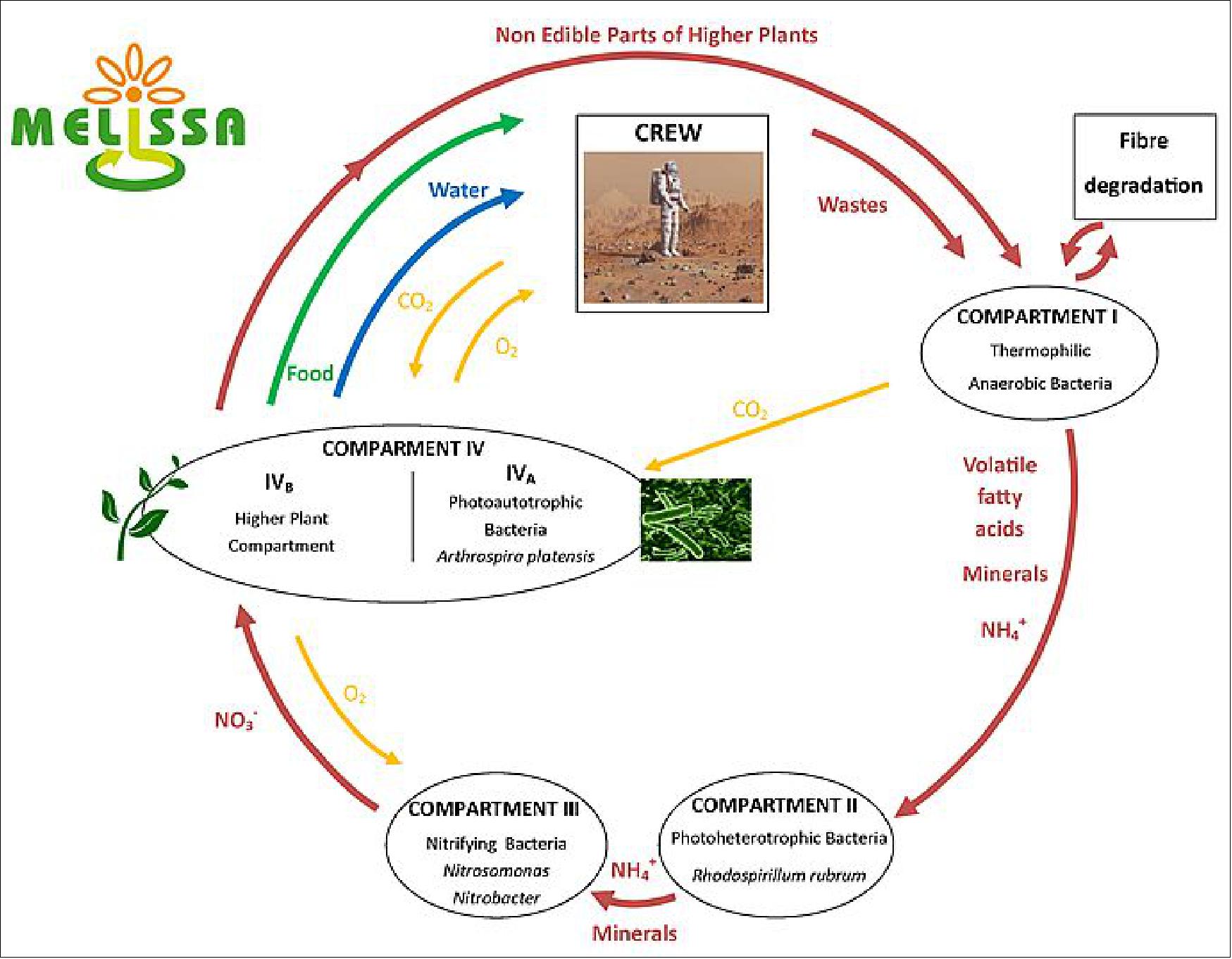
Development Status
• March 22, 2021: While demand for fresh water is increasing, water sources are becoming depleted and polluted. With the Global Water Partnership believing that sustainable development will not be achieved without a water secure world, can we look to space to solve our water security problems on Earth? 7)
- The more that astronauts can recycle, the fewer supplies they need to take into space. For almost three decades, ESA has been leading the development of a self-sustaining, waste-recycling ecosystem for use in space; the Micro-Ecological Life Support System Alternative (MELiSSA) aims to provide food, water and oxygen for crewed space missions.
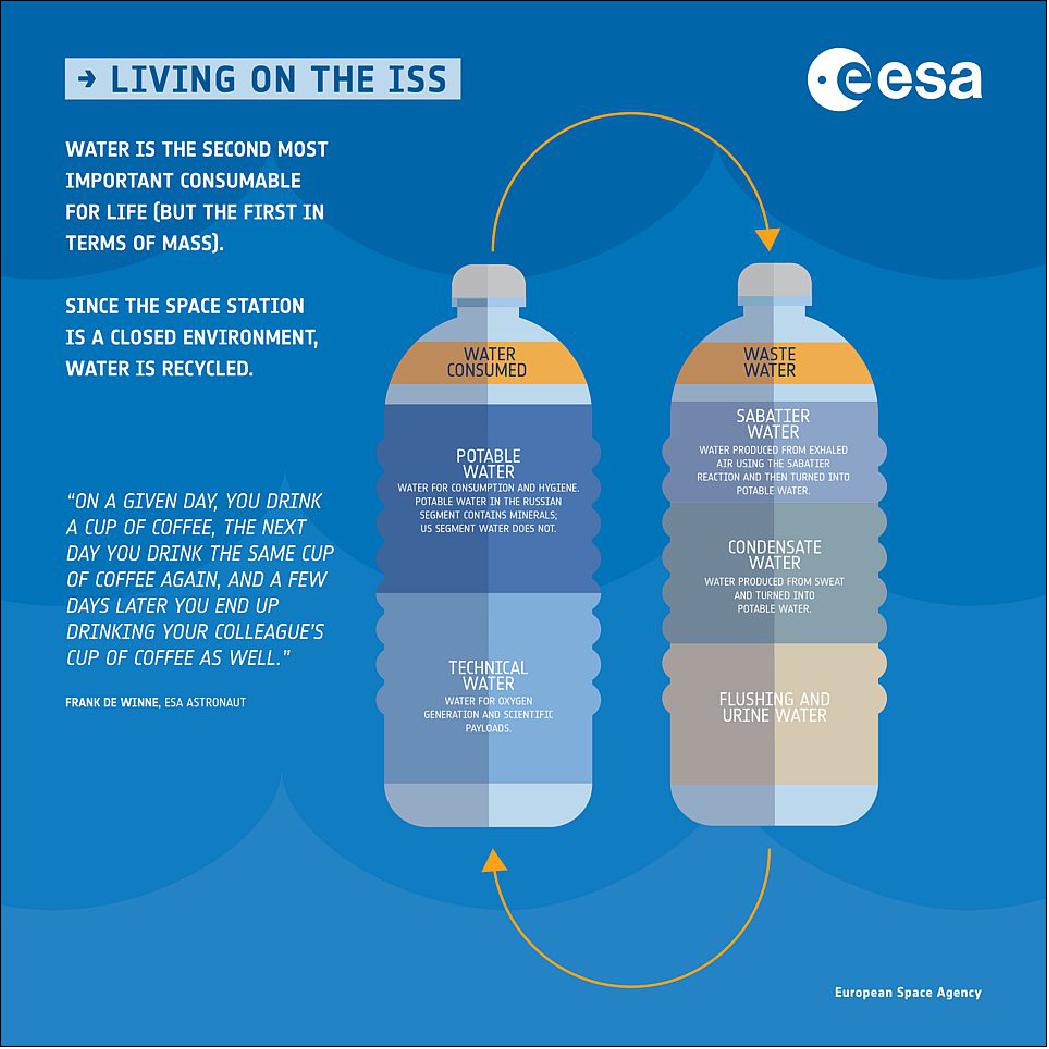
- The technology developed through the MELiSSA project has also been applied to building a more sustainable planet. To mark World Water Day 2021, we focus on some examples of applications that are contributing to advancing global water security.
Fresh Water in Morocco
- Through MELiSSA, organic and ceramic membranes were developed to filter astronauts' wastewater. Containing holes measuring just one ten-thousandth of a millimeter across – 700 times thinner than a human hair – these membranes can filter out unwanted compounds in water, in particular nitrates.
- The same technology is used to treat groundwater for a school in Morocco. The village of Sidi Taïbi near Kenitra, 30 km from Morocco’s capital city Rabat, has grown rapidly in the last two decades. Providing fresh water to its inhabitants is difficult because the groundwater is so rich in nitrates and fertilizer that it is unsuitable for human consumption.
- With help from a UNESCO partnership, the University of Kenitra sought to apply the membrane technology to tackle their drinking-water problem. Building on ESA’s experience, French company Firmus teamed up with Germany’s Belectric to build a self-sustaining unit powered by solar panels and wind energy.
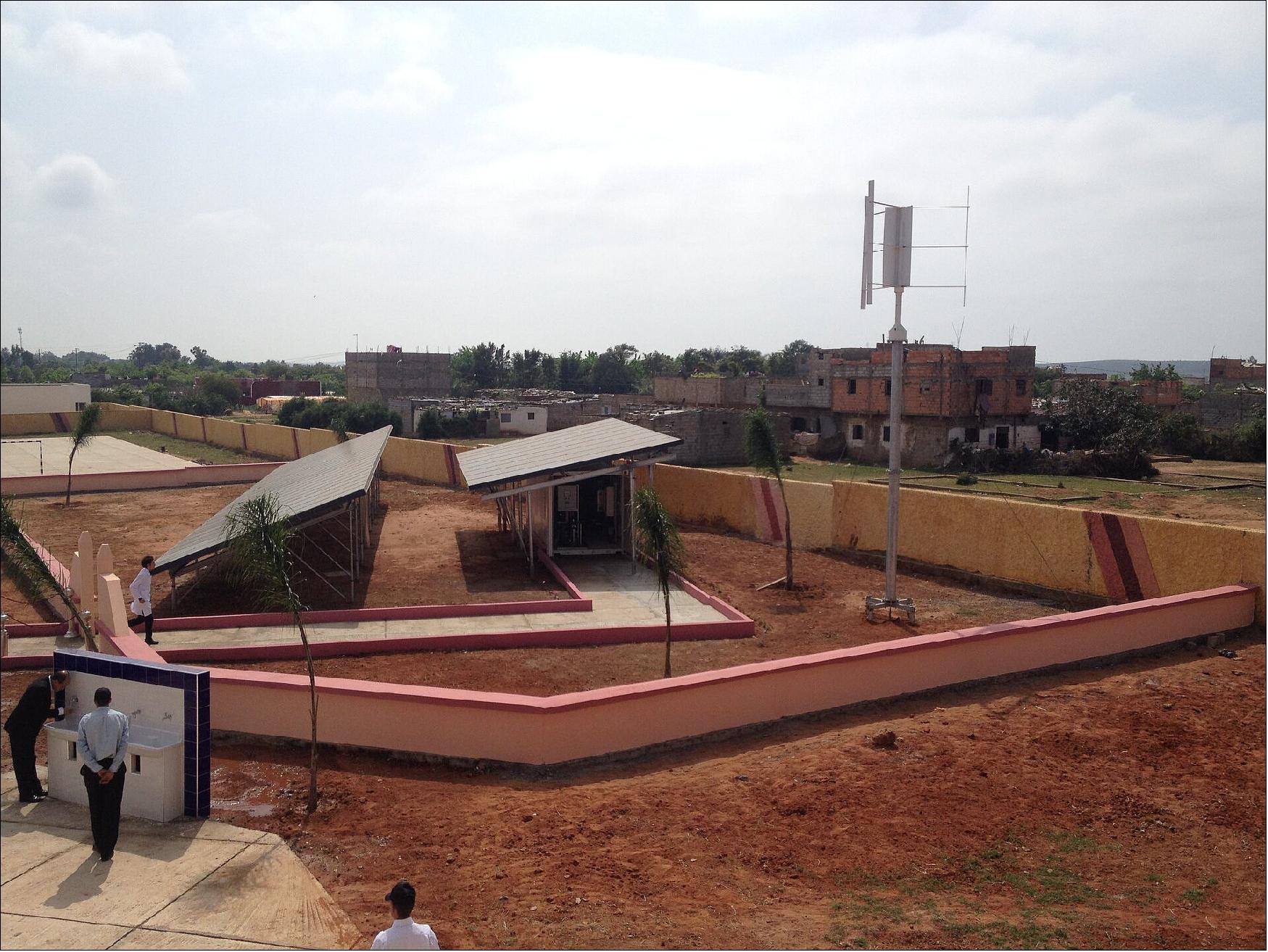
Worldwide Waste Treatment
- Also based on the membrane technology, SEMiLLA Sanitation Hubs provide toilet and washing facilities that recover and treat wastewater for continuous use. A unit was available at ESA's Open Day in 2019, where visitors could enjoy some tea and learn about the closed water loop.
- Used water, termed 'grey' (from washing up and showers), 'yellow' (urine) or 'black' (excrement) depending on its origin, is processed into hygienic water through a cascade of technologies. Diluted water molecules are further filtered out through the process of reverse osmosis, in which fluid is drawn through a membrane that only allows particles of a certain size to pass. Once the water has passed through the various types of filtration, the procedure ends with UV irradiation to kill the remaining bacteria and impurities. The water should then be ready for reuse.
- The company behind the sanitation hubs, SEMiLLA IPStar is a MELiSSA technology transfer partner. This means it applies MELiSSA technologies to Earth-based needs, including water treatment and waste management and recycling. Another project that SEMiLLA is working on is recovering water, energy and nutrients from urban wastewater in New Delhi, India. Specifically, these technologies are being incorporated into a modular pilot treatment plant along the Barapullah drain.
Electrifying Water
- A company called Hydrohm is also developing technologies for safe and sustainable toilets. The closet-sized URIDIS is a water treatment technology, the core of which was developed through the pool of MELiSSA PhDs (POMP) program. URIDIS has two functions – taking valuable components from urine (phosphorous, nitrogen and salt) and pre-treating toilet flushing water to disinfect it.
- Hydrohm was established in 2020 to develop electrifying water treatments as an opportunity to shift towards more local and sustainable water systems, with an increased focus on quality and health. As an alternative to treating water using chemicals, using electricity is renewable, economical, leaves no residue and can be done anywhere that there is an electricity connection. This makes it vital for countries hardest hit by a lack of water, which tend to be developing countries.
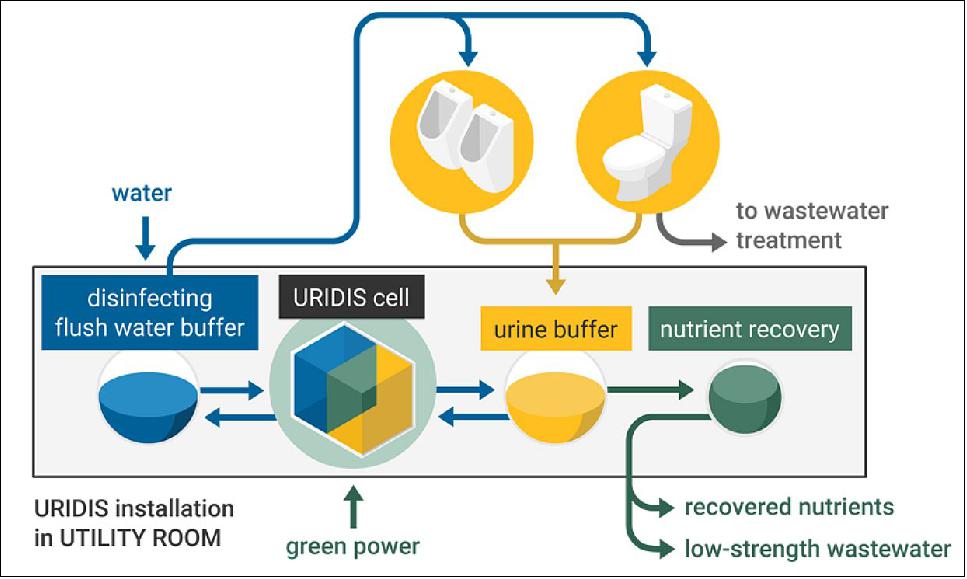
Optimizing Water Use in Hotels
- Hotels often use huge amounts of water, little of which is recycled. The MELiSSA consortium brought together partners, including Sherpa Engineering, to develop a grey water recycling system called AIGANOVA. The aim was to optimize the use of water and minimize the cost of a water facility in hotels and other places that use a lot of water. AIGANOVA was developed based on MELiSSA expertise already employed at the Concordia research station in Antarctica. It addressed two major societal concerns – water consumption and energy use in water recycling – and demonstrated the possibility to reduce external water resources by 50–80%.
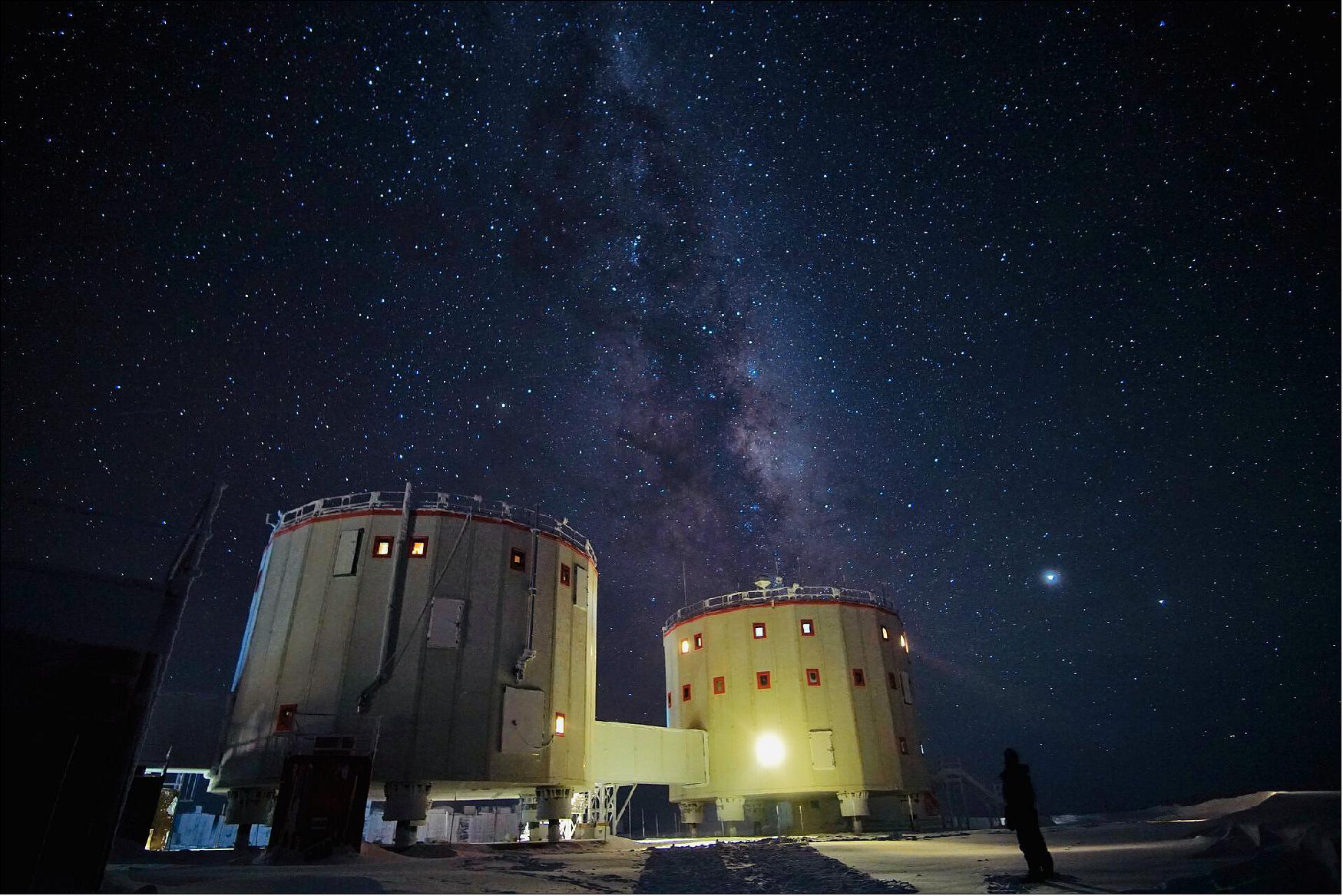
• April 5, 2019: Yesterday the MELiSSA pilot plant at the University of Barcelona celebrated 10 years spent demonstrating the ideal technologies to recycle waste from space missions into air, water and food. 8)
As astronauts explore farther into our Solar System, there will be a need to reduce the reliance on supplies brought from Earth. ESA is working with partners to create a contained system that will eventually and continuously convert carbon dioxide, urine and organic matter into fresh air, water and food – almost indefinitely. This system is known as MELiSSA (Micro-Ecological Life Support System Alternative). MELiSSA is divided into a number of different modules. Each module tackles one aspect of converting unwanted molecules into those humans need to survive.
On Earth, for example, trees, algae and plants all convert carbon dioxide from our exhaled breath into the oxygen we need to breathe. Melissa takes inspiration from these kinds of natural processes, but also investigates chemical processes, mechanical filters and bio-reactors full of bacteria or microalgae to develop systems needed to deliver a full meal, fresh drinking water and clean air in space.
At the pilot plant in Barcelona, Spain, modules are built and tested to validate each step of the self-contained loop. Once one element works as needed it can be combined into the next step, passing molecules through tubes to the next station as a liquid, a solid, or gas.
“We have been working on this for 30 years now and every year we get a bit closer,” says Christophe Lasseur, ESA’s head of the Melissa project. “Over the years we have demonstrated a robust and efficient way of transforming carbon dioxide from our crew compartment into oxygen and edible biomass. Recently, we also made substantial progress on transforming nitrogen waste into nutrients for plants and algae. Essentially, we are trying to duplicate the main functions of Earth’s ecosystem, without the huge atmosphere, ocean and soil buffers.”
To prove the system works, great care is taken to keep the crew habitat as airtight as the International Space Station. To avoid contamination, it is also built and run to the highest isolation standards in existence.
Christophe says the next step is to incorporate larger plants, work on food production and utilize carbon dioxide from organic waste. Meanwhile, the MELiSSA project team has already demonstrated elements of the system in space.
In December 2017, the ArtemISS photobioreactor on board the International Space Station proved a microalgae bioreactor can produce oxygen from carbon dioxide, and be highly resistant to radiation. The Nitrimel experiment, on a Russian satellite, also demonstrated that bacteria exposed to radiation from spaceflight still performs as well back on Earth, proving its viability.
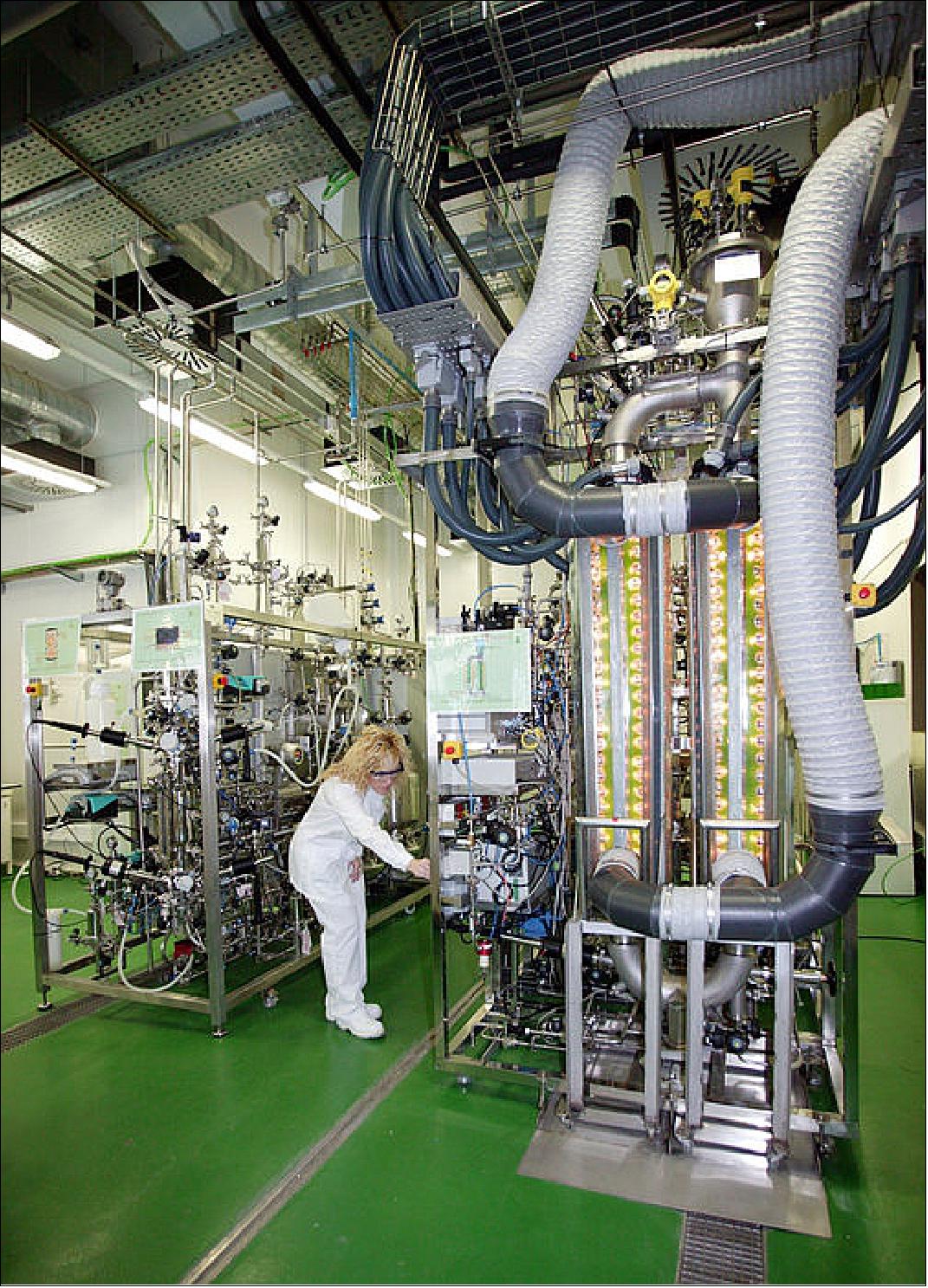
• December 21, 2018: For over 25 years, ESA has been working on an endless waste-recycling system to provide a self-sustaining ecosystem for humans in space. While we are not there yet, the technology developed to date is having immediate benefits for building a more sustainable planet – including at the La Trappe Abbey brewery in the Netherlands. 9)
When the monks from La Trappe Abbey brewery wanted to make their beer-brewing process more sustainable, they chose the suite of techniques developed for spaceflight to renovate their factory and recycle more water. Upon its completion in 2019, the system should reduce the amount of water used to brew their beer by 80%.
The brewery produces almost a million cubic meters of waste water each year. Thanks to the new recycling techniques this water will no longer be sent to a municipal processing plant but used to irrigate the monks’ land and clean beer bottles.
The system will recover water and purify it using membranes before employing photobioreactors to add nitrogen to the water. Around 3000 species of bacteria and organisms, including plants, will be used to purify the water. The system will also reduce the brewery’s electricity use.
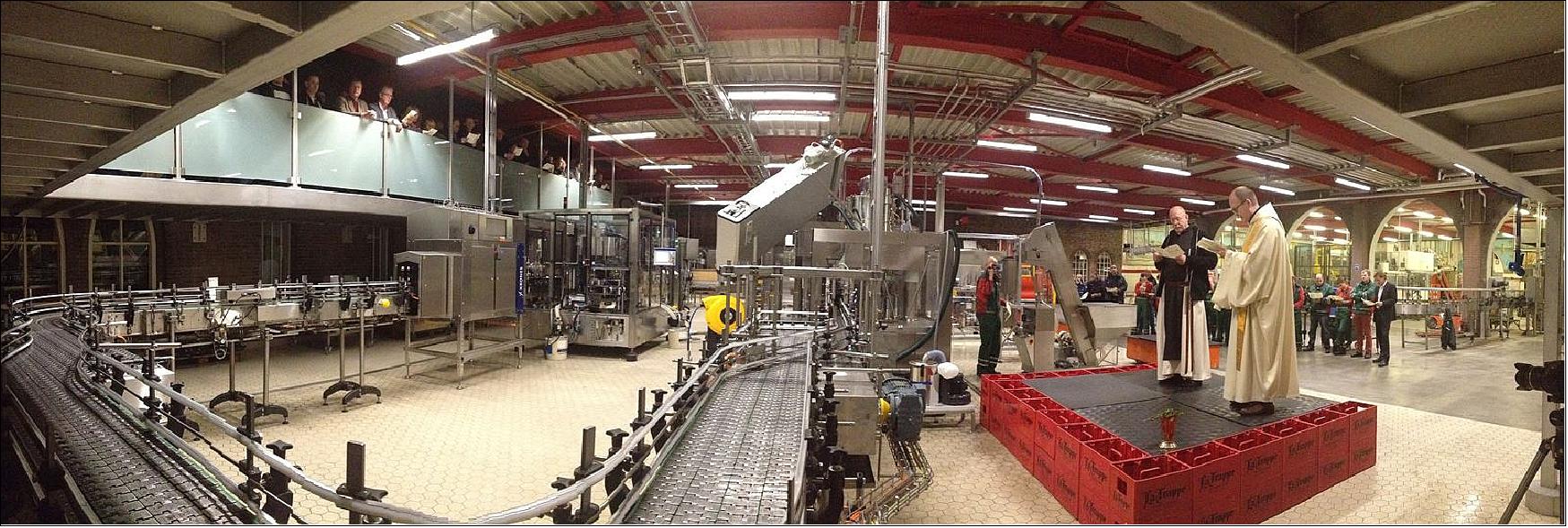
“In this case we applied our expertise and technological developments in a factory, but they could just as easily be incorporated into a hotel or other operation” says Christophe Lasseur, of ESA’s Life Support and Physical Sciences Instrumentation Section.
Using chemistry, biology and mechanical innovations, ESA’s MELiSSA (Micro-Ecological Life Support System Alternative) program’s research has already helped purify water in Morocco and developed bioreactors to grow new drugs. It has been recycling water in Antarctica for half a decade and a pilot project in Barcelona, Spain, is testing the system to the max with a fully closed, self-sustainable ecosystem for mice.
Provided funding by the European Union’s Horizon 2020 research and innovation program, the project at La Trappe has been awarded the innovation prize of 2018 by the Dutch councils of municipal water.

• July 24, 2017: The head of Europe’s effort to create a close-loop life support system for long-duration space missions has received a prestigious honorary doctorate – amid a busy period in the program’s 27-year history. 10)
Today, International Space Station crews must be resupplied from Earth, but such supply lines will become impractical as explorers venture farther out into space.
Instead, the ESA-led MELiSSA program seeks to perfect a self-sustaining life support system that could be flown in space in the future, supplying astronauts with all the oxygen, water and food they require.
The work of the 11-nation MELiSSA program was recognized this spring when its leader – Christophe Lasseur of ESA’s Life Support & Physical Sciences Instrumentation Section – received an honorary ‘Doctor Honoris Causa’ degree for scientific merit from the University of Antwerp’s Faculty of Science.
“The awarding of these honorary degrees by the University faculties is an annual event, acknowledging the quality of scientific work,” explains Christophe. “I myself don’t have a standard academic career: I have an engineer’s training and PhD but think of myself as a mix of engineer and a scientist – and MELiSSA, as a program, has a similar character.”
The award was preceded by a day-long symposium focused on MELiSSA and living in space, gathering together experts from across Europe – including a contribution from ESA astronaut Frank De Winne, currently head of the European Astronaut Center.
“MELiSSA is sometimes compared with the Biosphere-2 effort of the early 1990s, but our approach is very much different,” explains Christophe. “They shut themselves away to see how a separated biosphere would stabilise itself. Instead, we’ve followed a deterministic approach, to characterise all processes in as much detail as possible as a first step to recreating it, based on the knowledge we acquire.”
MELiSSA is a multi-faceted effort, with projects taking place all across European (and Canadian) universities and industry. But the program took an important step forward in 2001 with the first flight experiment then in 2009, with the inauguration of the ‘MELiSSA Pilot Plant’ at Spain’s University Autònoma of Barcelona (Figure 12).
“The Pilot Plant hosts a multi-compartment loop that is extremely airtight, like the ISS,” adds Christophe. “Last year, we ran a photo-bioreactor with a culture of algae that has succeeded in keeping ‘crews’ of three rats alive and comfortable for almost six months at a time. The algae produce the oxygen and trap the CO2, the rats do exactly the reverse.
“But we don’t do any animal research at all – all we ask our rats to do is breathe, they have a very comfortable time before being returned to the university veterinary services. Our algae is given light, heat and nutrients to trap the required quantity of carbon dioxide according to our mathematical model, and produce the oxygen in line with the rats’ consumption.
“To validate the robustness of our predictive control model we test it with several set-points, switching between different ‘steady states’ over time. -New compartments are being progressively integrated into the Pilot Plant as they are developed by MELiSSA partners, for systematic, long-term characterization and testing.”
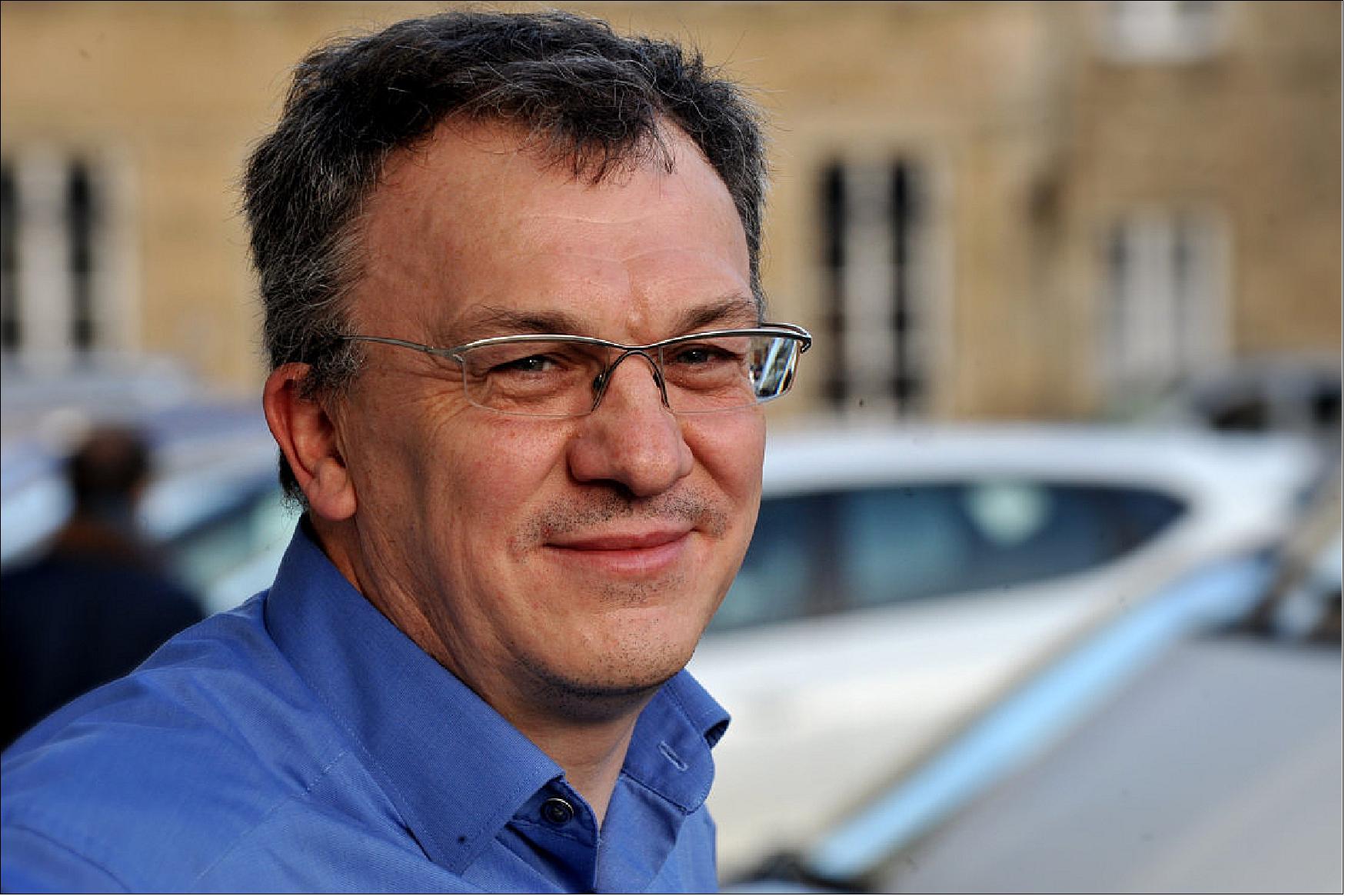
MELiSSA is attempting to recreate a streamlined version of aquatic terrestrial ecosystems – but that adds up to a formidable engineering challenge, requiring the detailed modelling and control of key processes, and the prevention of any contamination or degradation.
In September, the next MELiSSA experiment will be flown to the ISS: ArtemISS – short for ‘Arthrospira gene Expression and mathematical modelling on cultures grown in the International Space Station’ – contains a photo-bioreactor to see how algae growth rate is affected by microgravity and space radiation. Bioreactor-supported rats will follow ArtemISS later this decade.
Perfecting a ‘regenerative’ life support system that humans could reliably trust their lives to is forecast to take many more years yet: MELiSSA is regarded by members as a 50-year effort, resulting so far in hundreds of academic papers, patents and terrestrial spin-offs in areas ranging from food preparation to water purification and microbial safety.
Christophe puts MELiSSA’s survival down to its diversity – like the ecosystems it models, it has developed resilience: “ESA coordinates the program, but it receives contributions from the MELiSSA community, and several different organizations.
“We’re making progress in the fields of water processing, environmental management, the circular economy and urban farming as well as for space exploration; there are a lot of motivations in Europe, and this keeps us going.”
• In August 1987, an unusual delivery arrived at a hotel room in Beijing. A very simplified ecosystem limited to 2 microbial strains was sent on a five-day microgravity trip on a Chinese capsule. The algae survived the journey, and the idea behind the MELiSSA loop started to take shape. 11)
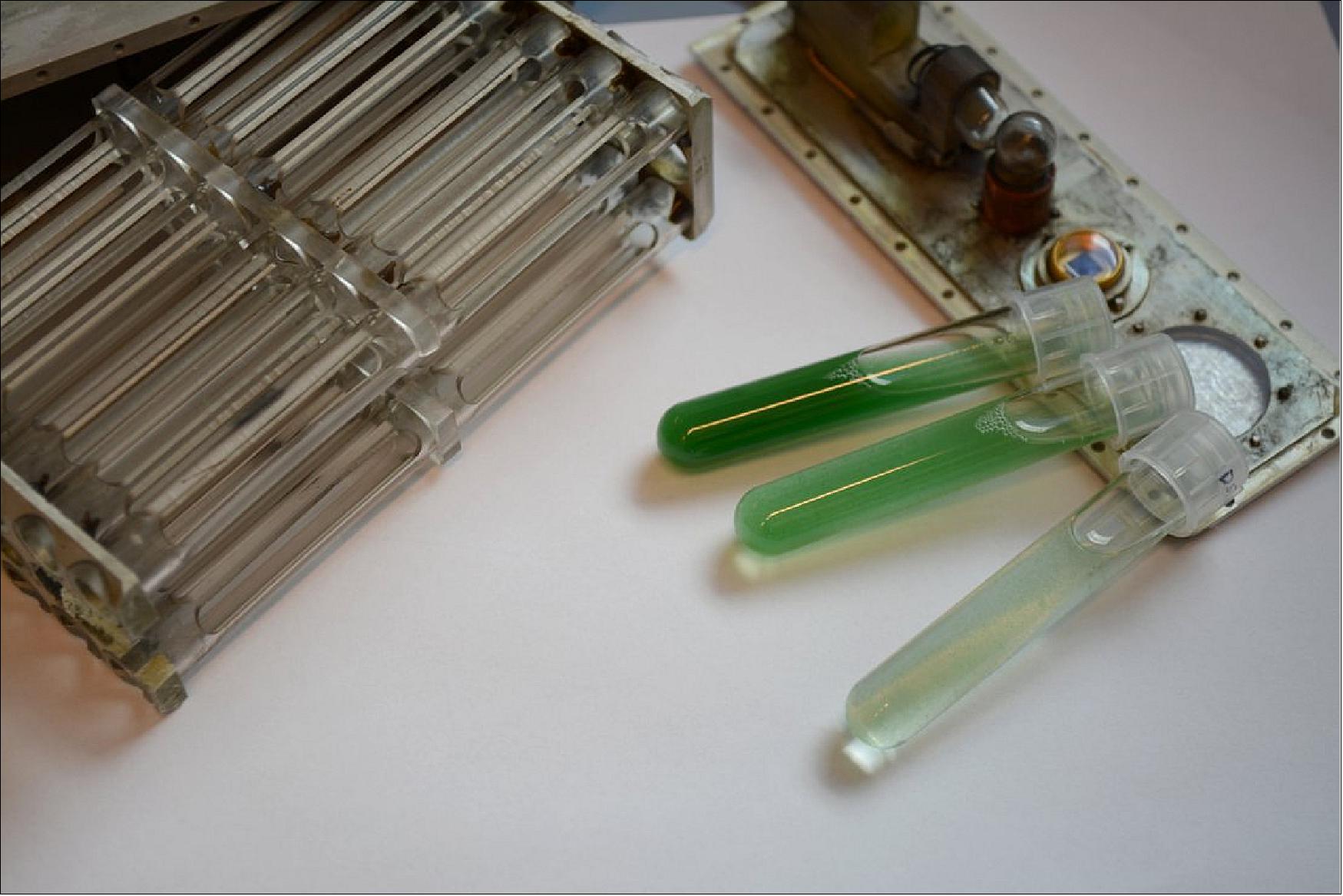
In 2014, ESA celebrated 25 years since the first official MELiSSA contract. MELiSSA was initially triggered by the long-term needs for human missions to the Moon and Mars. A possible solution to this problem was conceived as an artificial ecosystem. Investigating how to make it work encountered many similarities with ground-based environmental problems such as waste and water treatment, so technology developed through MELiSSA also offers solutions to global problems of sustainable development. In the 1980’s, several European visionaries wanted to learn how to recycle waste and carbon dioxide on spacecraft using bacteria. Under the impetus of them – Claude Chipaux and Daniel Kaplan of Matra Espace, Professor Max Mergeay of SCK, Professor Willy Verstraete of the University of Ghent and Professors Marcelle Lefor Tran and Guy Dubertret of CNRS - a group of European organizations sharing common interests decided to pool their efforts in the MELiSSA consortium. Their partnership was formalized through a joint Memorandum of Understanding signed in 1993, which evolved over the years.
These founders defined a long-term vision supported by short to medium term activities which included spin-in and spin-off activities, scientific and practical studies. In addition, as the project develops, more and more European organizations are contributing to the joint venture, introducing complementary expertise where needed.
References
1) ”Full circle: space algae fighting malnutrition in Congo,” ESA, Sept. 13, 2016, URL: http://m.esa.int/Our_Activities/Human_Spaceflight/Research
/Full_circle_space_algae_fighting_malnutrition_in_Congo
2) ”Extra-Terrestrial Ecosystems: The European Space Agency MELiSSA Program,The European Biotech News Website, ” URL: http://labiotech.eu
/extra-terrestrial-ecosystems-the-european-space-agency-melissa-program/
3) ”The MELiSSA Foundation -Knowledge of regenerative life support systems for long term space missions,” URL: http://www.melissafoundation.org/
4) Larissa Hendrickx, Heleen De Wever, Veronik Hermans, Felice Mastroleo, Nicolas Morina, Annick Wilmotte, Paul Janssen, Max Mergeay, ”Microbial ecology of the closed artificial ecosystem MELiSSA (Micro-Ecological Life Support System Alternative): Reinventing and compartmentalizing the Earth’s food and oxygen regeneration system for long-haul space exploration missions,” Research in Microbiology, Volume 157, 2006, pp: 77–86, URL: http://tinyurl.com/zvyu27z
5) C. Lasseur, J. Brunet, H. de Weever, M. Dixon, G. Dussap, F. Godia, N. Leys, M. Mergeay, D. Van Der Straeten, ”MELiSSA: The European project of closed life support system,” European Space Agency, TEC-MMG Keplerlaan 1, 2200 AG Noordwijk, The Netherlands, Gravitational and Space Biology , Vol. 23(2) August 2010, URL: http://citeseerx.ist.psu.edu/
viewdoc/download?doi=10.1.1.464.3630&rep=rep1&type=pdf
6) M. Mergeay, W. Verstraete, et al. (1988). "MELiSSA - A micro-organism-based model for CELSS (Controlled Ecological Life Support System) development," Proceedings of the 3rd European Symposium on Space Thermal Control and Life Support Systems, Noordwijk (The Netherlands) ESA SP-288, pp: 65- 69
7) ”How ESA technology contributes to worldwide water security,” ESA Enabling & Support, 22 March 2021, URL: https://www.esa.int/Enabling_Support/Preparing_for_the_Future/
Space_for_Earth/How_ESA_technology_contributes_to_worldwide_water_security
8) ”A decade-long quest to build an ecosystem in a room,” ESA, 5 April 2019, URL: http://m.esa.int/Our_Activities/Human_and_Robotic_Exploration
/Research/A_decade-long_quest_to_build_an_ecosystem_in_a_room
9) ”Water recycling for monks and astronauts awarded Dutch innovation prize,” ESA, 21 December 2018, URL: http://m.esa.int/Our_Activities/Human_Spaceflight/
Water_recycling_for_monks_and_astronauts_awarded_Dutch_innovation_prize
10) ”ESA’s MELiSSA life-support program wins academic recognition,” ESA, 24 July 2017, URL: http://m.esa.int/Our_Activities/Space_Engineering_Technology
/ESA_s_MELiSSA_life-support_programme_wins_academic_recognition
11) ”How it began,” ESA, Last update: 9 June 2015, URL: https://www.esa.int/Our_Activities/Space_Engineering_Technology/Melissa/How_it_began
The information compiled and edited in this article was provided by Herbert J. Kramer from his documentation of: ”Observation of the Earth and Its Environment: Survey of Missions and Sensors” (Springer Verlag) as well as many other sources after the publication of the 4th edition in 2002. - Comments and corrections to this article are always welcome for further updates (eoportal@symbios.space).